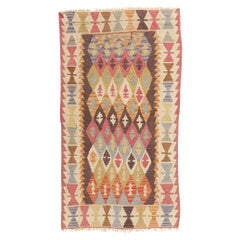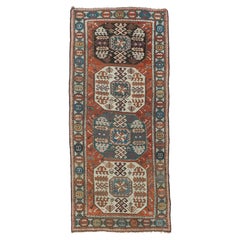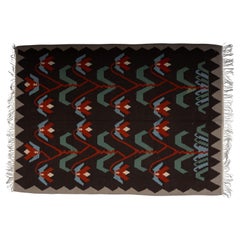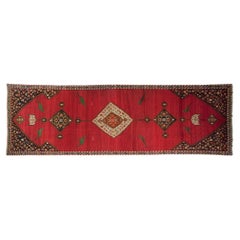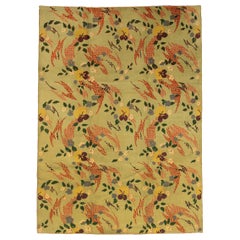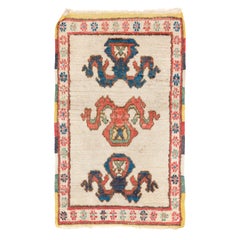Caucasian More Carpets
to
1,351
Width
to
Length
to
4,664
883
116
855
259
83
32
28
27
26
18
16
15
12
11
10
9
3
18
416
4,230
999
563
2,651
472
74
32
68
48
65
97
109
52
26
26
5,644
5,262
278
989
543
4,998
629
5,663
5,355
5,361
23,197
11,191
8,133
5,663
5,434
24
18
12
11
4
Place of Origin: Caucasian
1920’s Colorful Turkish Kilim Flatweave Carpet with Modern Tribal Style
Located in Dallas, TX
78951 Antique Turkish Kilim Rug, 02'11 x 05'03. This exquisite handwoven wool antique Turkish kilim rug embodies the rich tradition of tribal artistry, showcasing the timeless beauty...
Category
Early 20th Century Aesthetic Movement Caucasian More Carpets
Materials
Wool
Antique Kazak Rug 4'0" x 9'5''
Located in New York, NY
Antique Kazak Rug 4' x 9'5''.
Category
1880s Antique Caucasian More Carpets
Materials
Wool
$5,400 Sale Price
51% Off
21st Century Tribal Kilim
Located in Paradise Valley, AZ
This kilim rug is not just a piece of décor; it's a cultural tapestry woven with stories and heritage. Beyond its visual appeal, this rug serves as a bridge between the past and the ...
Category
2010s Kilim Caucasian More Carpets
Materials
Wool
Antique Karabagh Rug Runner
Located in Katonah, NY
:: Single column of center medallions with larger main medallion, atop an open field with male and female birds facing each other on an abrashed ground. Colors and shades include: Ch...
Category
Late 19th Century Other Antique Caucasian More Carpets
Materials
Wool
$28,580
Art Deco Green Turkish Rug Floral Design
Located in Ferrara, IT
Introducing the Green Art Deco Rug Allover Floral Design, 1950-1970! This beautiful rug is perfect for adding a touch of elegance to any home. The s...
Category
Mid-20th Century Art Deco Caucasian More Carpets
Materials
Cotton, Wool
25x38 in Semi Antique Rug with Colorful Border. Seat Cover or Door Mat. All Wool
Located in Spring Valley, NY
A small antique Turkish rug, wall hanging or mat with a tribal design and plant dyed colors.
Finely hand knotted with even medium wool pile on wool foundation.
Excellent condition. S...
Category
Early 20th Century Tribal Caucasian More Carpets
Materials
Wool
$671 Sale Price
30% Off
1920's Antique Turkish Sivas Carpet with Traditional Style
Located in Dallas, TX
79161 Antique Turkish Sivas Rug, 13'01 x 19'01. Bathed in Ottoman splendor and rich with cultural memory, this hand-knotted wool antique Turkish Sivas rug is a one-of-a-kind masterpi...
Category
Early 20th Century Romantic Caucasian More Carpets
Materials
Wool
Zabihi Collection Antique Turkish Oushak Room Rug
Located in New York, NY
an early 20th Century Turkish Antique Oushak Rug
Details
rug no. j3213
size 9' 6" x 12' 10" (290 x 391 cm)
Category
Early 20th Century Oushak Caucasian More Carpets
Materials
Wool
16"x32" Handmade Wall Hanging, Tapestry. 1 of a Pair of Vintage Pictorial Rug
Located in Spring Valley, NY
One of a kind and One of a pair of pictorial Turkish wall rugs dating back to mid 20th century.
This charming little work of art is depicting a beautiful natural scenery; a waterfa...
Category
Mid-20th Century Other Caucasian More Carpets
Materials
Wool, Cotton
1960's Turkish Oushak Rug with Modern Style
Located in Dallas, TX
52715 Vintage Turkish Oushak Rug, 03'05 x 04'08. From the storied looms of Anatolia, this hand-knotted wool vintage Turkish Oushak rug emerges as a singular testament to the marriage...
Category
Mid-20th Century Modern Caucasian More Carpets
Materials
Wool
Handwoven Carpet Rug Geometric Oriental Area Rug Traditional Gold Rug
Located in Wembley, GB
This beautiful Antique Persian rug was handwoven in Iran with hand-spun wool which has been dyed using organic vegetable dyes. Traditional weaving techniques were used by master weav...
Category
1920s Kazak Vintage Caucasian More Carpets
Materials
Wool, Cotton, Natural Fiber, Organic Material
$9,353 Sale Price
20% Off
Moghan Long Rug, Late 19th Century
Located in San Francisco, CA
Moghan Long Rug, Late 19th Century
Additional Information:
Dimensions: 3'9" W x 9'0" L
Origin: Caucasus
Period: Early 19th Century
Rug ID: 21978
Category
Late 19th Century Antique Caucasian More Carpets
Materials
Wool
New Modern Light Green Turkish Oushak Carpet with Contemporary Style
Located in Dallas, TX
54015 New Modern Light Green Turkish Oushak Rug, 08'03 x 09'06. Imbued with the elegance of centuries-old tradition and the whisper of Anatolian gardens, this hand-knotted wool Turki...
Category
21st Century and Contemporary Oushak Caucasian More Carpets
Materials
Wool
1960's Earth-Tone Turkish Oushak Carpet with Modern Style
Located in Dallas, TX
77707 Vintage Turkish Oushak Rug, 07'02 x 10'00. A vision of restrained grandeur and enduring refinement, this vintage hand-knotted Turkish Oushak rug embodies the rarefied beauty of...
Category
Mid-20th Century Oushak Caucasian More Carpets
Materials
Wool
Zabihi Collection Vintage Turkish Kars Rug dated 1906
Located in New York, NY
a Room size turkish Kars rug from the 20th century
Details
rug no. j3470
size 7' 9" x 11' 2" (236 x 340 cm)
Category
Early 20th Century Islamic Caucasian More Carpets
Materials
Wool
Antique Kula Long Rug
Located in New York, NY
Antique Kula Long runner rug. With tulips and carnations everywhere, this antique village rug is a direct descendant Ottoman Turkish weavings from the...
Category
19th Century Oushak Antique Caucasian More Carpets
Materials
Wool
$9,950
New Modern Light Green Turkish Oushak Carpet with Contemporary Style
Located in Dallas, TX
54006 New Modern Light Green Turkish Oushak Rug, 08'02 x 09'10. A masterwork of serene geometry and artisan heritage, this hand-knotted wool modern Turkish Oushak rug evokes a rarefi...
Category
21st Century and Contemporary Oushak Caucasian More Carpets
Materials
Wool
Zabihi Collection Vintage Turkish Anatolian Runner
Located in New York, NY
A colorful Turkish Anatolian runner from the middle of the 20th century. A formal palette with intense colors on a camel colored ground
Details
rug no. 31329
size 3' 3" x 12' 1" (99...
Category
20th Century Gothic Revival Caucasian More Carpets
Materials
Wool
Antique Turkish Tree of Life Oushak Rug
Located in Dallas, TX
74049 Antique Turkish Oushak Tree of Life Rug, 04'09 x 06'05. Turkish Oushak Tree of Life rugs are traditional handwoven rugs originating from the Oushak region of Turkey, renowned f...
Category
Early 20th Century Oushak Caucasian More Carpets
Materials
Wool
1950's Muted Turkish Oushak Carpet with Modern Style
Located in Dallas, TX
53997 Vintage Muted Turkish Oushak Rug, 06'10 x 10'06. This hand knotted wool vintage Turkish Oushak rug is a one-of-a-kind vision of restrained grandeur, where every motif speaks in...
Category
Mid-20th Century Oushak Caucasian More Carpets
Materials
Wool
Forest Green Wide Antique Turkish Oushak Runner
Located in New York, NY
An early 20th century antique Oushak runner in forest green, gold and ivory
Measures: 3'10'' x 11'10''.
Category
Early 20th Century Arts and Crafts Caucasian More Carpets
Materials
Wool
Zabihi Collection Antique Turkish Melas Early 20th Century Runner
Located in New York, NY
An early 20th century Turkish Melas Runner
Details
rug no. 31700
size 3' 3" x 11' 6" (99 x 351 cm)
Category
Early 20th Century Oushak Caucasian More Carpets
Materials
Wool
Vintage Kilim Rug 3'2'' x 5'8''
Located in New York, NY
Vintage Kilim rug 3'2'' x 5'8''. This rustic textile shows irregular horizontal abrashed rust, cream and light blue bands, enriched by extra-weft her...
Category
1650s Antique Caucasian More Carpets
Materials
Cotton, Silk
9x12 Ft Contemporary Hand Knotted Moroccan Style Rug. Custom Options Available
Located in Spring Valley, NY
Elevate your living space with the exquisite charm of this new modern hand-knotted Moroccan Berber Beni Ourain design rug, crafted with precision and care from 100% wool. Combining t...
Category
21st Century and Contemporary Modern Caucasian More Carpets
Materials
Wool
$1,889 Sale Price / item
50% Off
Checkerboard Deco Turkish Runner
Located in New York, NY
Mid-Century Turkish deco runner with an all-over checkerboard design. Plum , green, brown, pink and ivory acccents are dominants
3' x 6'9''
Category
Mid-20th Century Mid-Century Modern Caucasian More Carpets
Materials
Wool
$1,000 Sale Price
20% Off
1950's Muted Turkish Oushak Carpet with Contemporary Style
Located in Dallas, TX
53712 Vintage Muted Turkish Oushak Rug, 06'06 x 15'03. Woven with quiet eloquence and the disciplined grace of Shibui aesthetics, this hand knotted wool vintage Turkish Oushak rug is...
Category
Mid-20th Century Oushak Caucasian More Carpets
Materials
Wool
Zabihi Collection Gray Antique Turkish Oushak Rug
Located in New York, NY
an early 20th Century Oushak room-size rug
Details
rug no. 10080
size 9' 3" x 13' 3" (282 x 404 cm)
Category
Early 20th Century Country Caucasian More Carpets
Materials
Wool
6.4x8.8 Ft Handmade Vintage Turkish Wool Rug Re-Dyed in Brown 4 Modern Interiors
Located in Spring Valley, NY
Our over-dyed rugs are all hand-knotted vintage pieces that are recreated in our workshop to cater to a wider range of interior design choices from modern to coastal, from industrial...
Category
20th Century Modern Caucasian More Carpets
Materials
Wool, Cotton
$784 Sale Price
30% Off
Tribal Mid-20th Century Turkish Flatweave Kilim Accent Rug in Brown & Cream
Located in New York, NY
A vintage Turkish tribal flatweave Kilim accent rug handmade during the mid-20th century in shades of brown and cream.
Measures: 6' 0" x 8' 3".
Category
Mid-20th Century Tribal Caucasian More Carpets
Materials
Wool
Long Narrow Bright Turkish Kilim Runner
Located in New York, NY
Colorful casual long Kilim runner from the mid-20th century. Bright pinks, black orange, lime green, fuchsia highlight the color accents on an ivory ground.
Measures: 1'10” x 21'1”.
Category
20th Century Bohemian Caucasian More Carpets
Materials
Wool
Vintage Turkish Oushak Rug with Aesthetic Movement Style
Located in Dallas, TX
52337, vintage Turkish Oushak rug with Aesthetic Movement style. This hand knotted wool vintage Turkish Oushak rug features a compartmentalized design composed of varying rectangular...
Category
Mid-20th Century Tribal Caucasian More Carpets
Materials
Wool
Handmade Turkish Kilim Traditional Wool Rust-Red Flat-woven Area Rug Geometric
Located in Wembley, GB
This antique tribal kilim is a bold accent rug woven with elegance and delicacy. This kilim has been woven with a rich red background with accents of black, yellow, green and light b...
Category
Early 1900s Kilim Antique Caucasian More Carpets
Materials
Wool, Cotton, Natural Fiber, Organic Material
$3,732 Sale Price
20% Off
Vintage Turkish Oushak Geometric Overall Beige Oushak
Located in New York, NY
10x14 Vintage Oushak Rug Mahal Blue Rug Handmade Vintage Rug Area Rug Beige Blue
9'10" x 13'7"
10' x 14'
300cm x 414cm
"Gorgeous vintage Oushak in a stunning colorway. So...
Category
1970s Vintage Caucasian More Carpets
Materials
Wool
Antique Oushak Runner, Turkish and Oriental Rug, Handmade Beige Rug
Located in Port Washington, NY
West Anatolia is one of the largest weaving regions in Turkey. Since the 15th century, Turkish rugs have always been on top of the list for having fine oriental rugs.
Oushak rugs su...
Category
Early 20th Century Oushak Caucasian More Carpets
Materials
Wool
$5,599 Sale Price
20% Off
Pure silk Hereke Ozipek Prayer rug
Located in Lohr, Bavaria, DE
Very fine turkish pure silk Hereke prayer rug from the famous Ozipek workshop. Unusual geometric design gives this masterpiece a rarely seen look.
Category
20th Century Islamic Caucasian More Carpets
Materials
Silk
Zabihi Collection Vintage Turkish Anatolian Runner
Located in New York, NY
A colorful full pile vintage Turkish runner from the mid-20th century.
2'9'' x 12'6''
Category
20th Century Bohemian Caucasian More Carpets
Materials
Wool
$3,000 Sale Price
20% Off
Vintage Turkish Hereke Rug Cotton Kaysari Birds Tapestry Tree of Life Rug
Located in New York, NY
Rare Vintage Turkish Rug Hereke cotton Kaysari Bird Tapestry
3'10" x 5'9' 4 x 6
117cm x 176cm
"This is an exquisite Vintage Cotton Turkish Herek...
Category
1960s Vintage Caucasian More Carpets
Materials
Cotton
Zabihi Collection Vintage Turkish Anatolian Scatter Square Size Floral Rug
Located in New York, NY
mid-20th-century Turkish Anatolian scatter-size square rug
rug no. j3453
size 3'8" x 4'4"
Category
20th Century Oushak Caucasian More Carpets
Materials
Wool
Antique Turkish fine weave Oushak Rug in Light Green and Color Variation
Located in Atlanta, GA
Early 20th century finely woven antique Turkish Oushak rug with abrash/color variation in the center. The background consist of light Green Background with pink and blue. Keivan Wov...
Category
Early 20th Century Oushak Caucasian More Carpets
Materials
Wool
Elegant and Soft Oushak Prayer Scatter Rug
Located in San Francisco, CA
Soft wool and a soft palette join in this lovely niched Oushak prayer rug from western Anatolia. The columns and spandrels as well as the palmette and leaf pattern of the border all ...
Category
19th Century Antique Caucasian More Carpets
Materials
Wool, Cotton
Vintage Turkish Silk Hereke Rug with Seven Mountain Flowers Design
Located in Dallas, TX
77795 Vintage Turkish Silk Hereke Rug with Seven Mountain Flowers Design, 03'01 x 04'09. Step into a realm of cultivated rarity with this hand-knot...
Category
Mid-20th Century Medieval Caucasian More Carpets
Materials
Silk
Vintage Turkish Oushak Rug with Mission Style and Muted Colors
Located in Dallas, TX
52462 vintage Turkish Oushak rug with Mission style and muted colors. This hand knotted wool vintage Turkish Oushak Rug is delicately ornamented with an inconspicuous center medallio...
Category
Mid-20th Century Oushak Caucasian More Carpets
Materials
Wool
Zabihi Collection Antique Turkish Melas Rug
Located in New York, NY
An early 20th-century Turkish Melas Decorative Rug
Details
rug no. 30352
size 3' 6" x 5' 2" (107 x 157 cm)
Category
Early 20th Century Oushak Caucasian More Carpets
Materials
Wool
Late 19th Century Turkish Oushak Carpet with Modern Style
Located in Dallas, TX
79232 Late 19th Century Antique Pastel Turkish Oushak Rug, 11'08 x 14'07. An opportunity of breathtaking rarity, this one-of-a-kind, hand-knotted wool Oushak rug from the Late 19th C...
Category
Late 19th Century Oushak Antique Caucasian More Carpets
Materials
Wool
Antique Caucasian Rose Karabakh Rug
Located in Dallas, TX
61061 Antique Caucasian Rose Karabagh Rug, 04'03 x 08'03. Caucasian Karabagh rugs originate from the Karabakh region of the Caucasus, now part of Azerbaijan, and are prized for their intricate geometric designs, vibrant colors, and durable wool construction. These rugs typically feature bold patterns such as medallions and stylized florals, woven using the symmetrical knotting technique. They vary in size and shape, from small prayer rugs to room-sized carpets, and hold cultural significance as symbols of status and craftsmanship within the Caucasus region. Widely traded and collected, Caucasian Karabagh rugs continue to be revered for their beauty and quality, with artisans maintaining traditional production methods to this day.
With its classic style, incredible detail, and texture, this hand-knotted wool antique Caucasian Karabakh rug...
Category
Early 20th Century Kazak Caucasian More Carpets
Materials
Wool
$5,040 Sale Price
26% Off
Zabihi Collection Vintage Turkish Kars Geometric Rug
Located in New York, NY
a mid-20th century Turkish Kars Rug with a large-scale geometric design
Details
rug no. j4305
size 8' 1" x 12' 7" (246 x 384 cm)
Category
Early 20th Century Islamic Caucasian More Carpets
Materials
Wool
Antique Caucasian Karabagh Runner. Size: 5 ft 3 in x 15 ft 4 in
Located in New York, NY
Antique Karabagh Runner Rug, Caucasus, Circa 1900. Size: 5 ft 3 in x 15 ft 4 in (1.6 m x 4.67 m).
Category
Early 20th Century Art Nouveau Caucasian More Carpets
Materials
Wool
Zabihi Collection Antique Turkish Sivas Rug
Located in New York, NY
an early 20th Century Turkish Sivas Rug. red accents on a blue ground
Details
rug no. 31792
size 8' 4" x 11' 4" (254 x 345 cm)
rug type Sivas
Category
Early 20th Century Agra Caucasian More Carpets
Materials
Wool
Zabihi Collection Antique Oushak Rug
Located in New York, NY
1930s Turkish Oushak room size rug
Details
rug no. j3299
size 8' 2" x 10' (249 x 305 cm)
rug type Oushak
Category
Early 20th Century Oushak Caucasian More Carpets
Materials
Wool
Late 19th Century Distressed Antique Caucasian Kazak Tribal Carpet
Located in Dallas, TX
78786 Antique Caucasian Kazak Rug, 03'09 x 06'03. Originating from the Caucasus region and deeply rooted in Kazakh culture, Caucasian Kazak rugs epitomize a legacy of meticulous hand...
Category
Late 19th Century Kazak Antique Caucasian More Carpets
Materials
Wool
5x9.6 Ft Vintage Handwoven Colorful Kilim. All Wool. Bohemian Style Turkish Rug
Located in Spring Valley, NY
This authentic hand-woven rug made to be used by the villagers in Central Anatolia. 100% organic wool.
Good condition and cleaned professionally.
Ideal for both residential and comm...
Category
Late 20th Century Kilim Caucasian More Carpets
Materials
Wool
$1,061 Sale Price
30% Off
Handwoven Antique Runner Rug, Long Traditional Oriental Wool Rug
Located in Miami, FL
This captivating antique hand-knotted wool runner rug, possibly woven in the late 19th or early 20th century, showcases the enduring artistry of traditional rug-making. The central medallion design in rich rust and blue tones is complemented by delicate floral motifs, offering a touch of timeless elegance. Featuring a standard pile height, this rug provides both comfort and beauty. Constructed using time-honored techniques, such as, hand-spinning the wool and organic dyeing, this piece offers unique characteristics that may appeal to collectors.
Measuring 16 feet long and nearly 4 feet 8 1/2 inches wide, this handwoven antique runner rug...
Category
Early 20th Century Caucasian More Carpets
Materials
Wool, Cotton, Natural Fiber
$7,200 Sale Price
52% Off
Kuba Kilim Rug
Located in New York, NY
Kuba Kilim rug. An old tribal Kilim rug from the Caucasus with somewhat unusual design.
Category
Early 20th Century Caucasian More Carpets
Materials
Wool
$3,250
New Contemporary Turkish Oushak Rug Repurposed from Antique Wool
Located in Dallas, TX
52508 New Modern Turkish Oushak Rug, 11'11 x 15'00. Behold this enchanting hand-knotted wool contemporary Turkish Oushak rug, where timeless tradition meets modern elegance. Its grand design features a majestic four-point medallion, gracefully adorned with finials at either end. The geometric pattern unfolds in a symphony of Harshang-style motifs and blooming palmettes, creating an organic dance upon an abrashed field. Each element harmonizes beautifully, telling a story of artistry and craftsmanship that transcends time.
Encircling this magnificent medallion is a border rich in heritage, a variation of the Herati and palmette designs, further embellished with subsidiary guard borders. These intricate frames add depth and dimension, guiding the eye along paths of history and beauty. The careful composition ensures that every glance reveals a new detail, a hidden treasure waiting to be discovered. The colors, vivid and subtle, blend seamlessly, invoking a sense of tranquility and grandeur.
What makes this contemporary Turkish Oushak rug even more captivating is its journey of transformation. Crafted from the wool of an antique Kilim, over a century old, the process begins with the careful unraveling of its fibers. This precious wool, steeped in history, is then lovingly re-woven into a new masterpiece, breathing new life into an age-old tradition. The result is a rug that not only adorns your space but also carries the whispers of generations past, making it a truly unique and enchanting addition to any home.
Rendered in variegated shades of sage, moss, fern, olive, dark green, red, ruby red, crimson, beige, sand, tan, buff, ecru, taupe, coral, peach, eggplant, charcoal, coffee, brown, saffron, teal, and cerulean with colorful striations.
Complementary Sherwin Williams Colors and Hues: Garden Sage, Verde Marron, Red Bay, Sawgrass Basket, Weathered Shingle, Raging Sea, Hinoki, Believable Buff, Fenland, Foxy, Sturdy Brown, Heartthrob, Ravishing Coral, Thunderous, Netsuke, Roycroft Brass, Ruskin Room Green, Roycroft Copper...
Category
21st Century and Contemporary Medieval Caucasian More Carpets
Materials
Wool
6.5x9.6 Ft Modern Handmade Turkish Kayseri Wool Area Rug in Shades of Green
Located in Spring Valley, NY
A hand-knotted contemporary Turkish rug.
This modern rug has even medium wool pile on wool foundation.
It is made of premium hand-spun sheep and natural dyes, ie. plant based non c...
Category
Early 2000s Rustic Caucasian More Carpets
Materials
Wool
$1,455 Sale Price
30% Off
Handmade Shabby Chic Turkish Vintage Wool Area Rug in Burgundy Red
Located in Spring Valley, NY
Our over-dyed rugs are all hand-knotted vintage pieces that are recreated in our workshop to cater to a wider range of interior design choices from modern to coastal, from industrial...
Category
20th Century Modern Caucasian More Carpets
Materials
Wool, Cotton
$597 Sale Price
40% Off
3.2x6.5 Ft Handmade Anatolian Village Small Rug, Vintage Tribal Style Carpet
Located in Spring Valley, NY
A vintage Turkish Oriental accent rug. Finely hand-knotted with even medium wool pile on cotton foundation. Very good condition. Sturdy and as clean as a brand new rug (deep washed p...
Category
Mid-20th Century Tribal Caucasian More Carpets
Materials
Wool, Cotton
$450 Sale Price
34% Off
Turkish Embroideries Flat-Weave Kilim with Geometric and Colorful Stripes
Located in Atlanta, GA
Stripe design Embroideries Kilim flat weave with geometric motifs, Color tones include various shades of gray, blues, pinks, cream, with hints of purple throughout. rug TU-NED-1037, ...
Category
Mid-20th Century Kilim Caucasian More Carpets
Materials
Wool
Vintage Turkish Silk Hereke Prayer Rug with Tree of Life Design & Ottoman Style
Located in Dallas, TX
77476 vintage Turkish Silk Hereke prayer rug with Tree of Life Design and Ottoman style. Give the look of woven wonders and warmth with this hand kno...
Category
Late 20th Century Rococo Caucasian More Carpets
Materials
Silk
Zabihi Collection Vintage Turkish Floral Konya Runner
Located in New York, NY
Floral Turkish Runner with large flowers on a cream ground from the middle of the 20th century
Details
rug no. 31305
size 2' 10" x 7' 4" (86 x 224 cm)
Category
20th Century Mid-Century Modern Caucasian More Carpets
Materials
Wool
Recently Viewed
View AllMore Ways To Browse
Vintage Finger Bowls
Vintage French Coffee Bowls
Vintage Garter
Vintage Grape China
Vintage Gucci Decor
Vintage Hunting Vases
Vintage Keyhole Glasses
Vintage Lenox Porcelain
Vintage Metal Rabbit
Vintage Moorcroft
Vintage Wooden Owl
Wedgwood Bird
Wedgwood Black Basalt Vase
Wedgwood Bone China
Wedgwood Cup Saucer
Willy Guhl Chair Concrete
Wooden Elephant Tusk
Wooden Sledge
